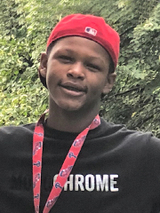Acute Liver Failure and Liver Transplant: Budd’s Story
Acute Liver Failure and Liver Transplant: Budd’s Story
When Budd was 14, he went from being a healthy boy, playing football and basketball and dancing, to a medical crisis — very close to death — in a matter of days. His decline was so rapid, and his recovery after his liver transplant so fast, that he has no memories of the days he spent in medical crisis.
From feeling bad to a medical emergency

The week after Easter, during a family visit, Budd told his mother, Pam, he wasn’t feeling well, that his stomach felt bad. He had no fever or other outward signs of illness, so the family decided to wait it out and see if he got better. He went to school that week, still not feeling like himself. On Friday, Budd called Pam from school to come pick him up in the middle of the day.
“When I got there, he had his hood up, which wasn’t like him,” says Pam. “I asked him to tell me what was wrong, whether he had a fever or was throwing up. He said, ‘My stomach feels toxic. I feel really sick. The other kids say my eyes are yellow.’ I asked him to pull his hood down so I could look at him. His eyes were canary yellow.”
Pam knew that meant he had a problem with his liver. She rushed him straight to the emergency room at Children’s Hospital of Philadelphia (CHOP). “They took him right in,” she remembers. “Within 10 minutes he had a team of doctors around him.” He was approaching liver failure.
Critical gastroenterology care at CHOP
Over the next few days, Budd’s medical team was led by Henry Lin, MD, a pediatric gastroenterologist who is a member of CHOP's Biesecker Liver Center and a leader in the Liver Transplant Program. Rachel Goldberg, MSN, CRNP, a liver transplant coordinator and nurse practitioner, Hamidah McCorkle, BSN, RN, a transplant nurse, and Elizabeth Rand, MD, Medical Director of the Liver Transplant Program, were also key members of the team.
Even with intensive medical care, Budd’s condition worsened. He became lethargic, then there was a buildup of toxins in the brain that’s usually cleared by the liver, which made him uncooperative. “He was fighting with the medical team,” says Pam. “He climbed under the bed. When he spoke, it wasn’t his voice. All he did was scream, ‘Help me! Help me!’ He needed to be sedated and restrained. I didn’t think he was going to make it. I was really afraid of losing him. I was at the chapel every day.”
The suddenness of his decline made it hard for the family to come to terms with his situation. Budd’s stepfather, Rick, had been at the hospital with Pam from the first day. Budd’s entire — rather large — family rallied to be by his side and give support. Visitors included Budd’s seven brothers and sisters, their children, Pam’s mother, and other family members. Pam’s aunt and grandmother, both nurses, came up from Delaware.
An urgent liver transplant was needed
As Budd’s condition declined, his medical team talked to Pam and Rick about a liver transplant. It became clear he would soon need a transplant to survive.
Budd was placed on the transplant list. As the days went by and his situation became more critical, his status rose. He was soon listed as 1A status, which put him at the top of the list should a suitable donor liver become available.
The family had an emotional meeting with Abraham Shaked, MD, PhD, Director of the Liver Transplant Program at the Hospital of the University of Pennsylvania and Co-director of the surgical Liver Transplant Program at CHOP. During the meeting he asked Budd’s next-older sister, who was 16 at the time, what her hopes were for Budd. “She said, ‘I just want my brother to live,’” Pam remembers. “He told her, ‘I promise you we will get him a liver.’”
He was true to his word. On day nine of Budd’s hospital stay, the medical team let Pam and Rick know a liver was available. They would begin preparing Budd for the transplant surgery while the donor liver was brought back to CHOP. Assuming it was a suitable organ, Budd would get his transplant that day.
“The only thing I could do was thank God and pray this liver was good for Budd,” Pam says.
It was a suitable organ. Budd was in surgery for eight hours while the entire extended family waited for news. They received updates every few hours during the surgery. Then Dr. Shaked told them it was done and had gone well.
A dramatic recovery from transplant

Budd had been so sick before the transplant that it took time for the new liver to work the toxins out of his body. But two weeks after surgery, Pam and Rick brought Budd home.
From there, his recovery went as rapidly uphill as it had gone downhill before the transplant. When Pam brought him back for a one-month follow-up appointment, his medical team hardly recognized him. They had never seen him healthy before.
Two years later, at age 16, Budd is back to doing the things he loves. He doesn’t play football anymore because of the risk of contact injury, but he plays basketball and he’s dancing again. His immune system is weaker due to anti-rejection drugs, but he still does much of what he loves.
Budd is an outgoing, funny kid, and has lost none of that charm. He is popular among the staff when he comes back to CHOP for follow-up visits.
"They saved his life," says Pam.
“If your child is sick, CHOP is the best hospital in the world. There’s no place better. They work miracles.”